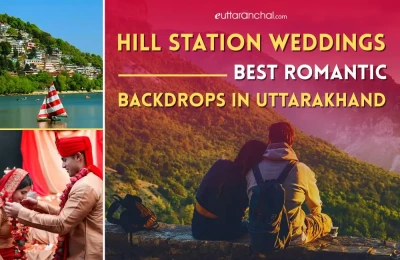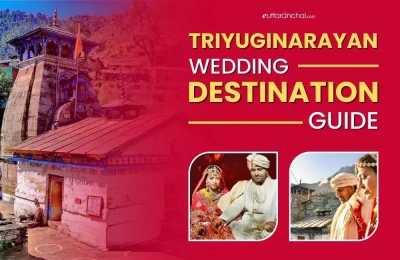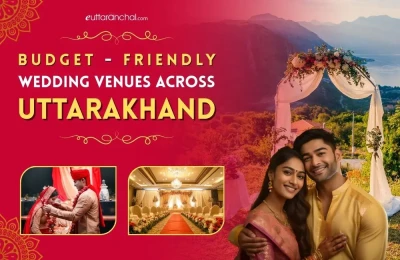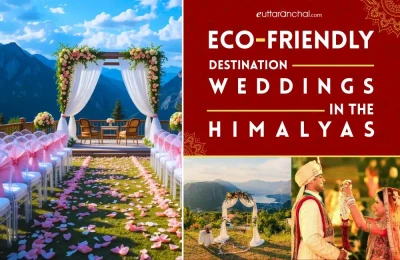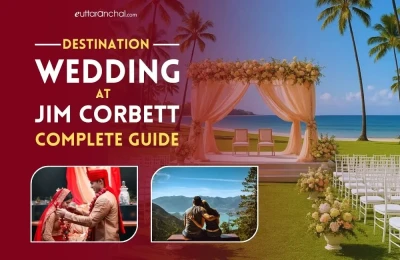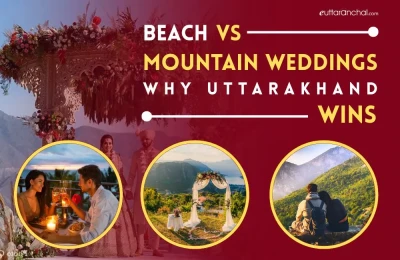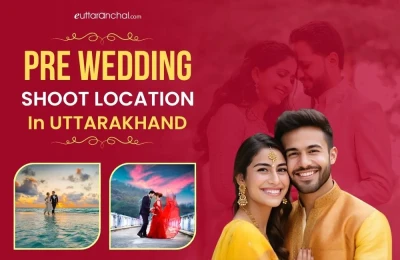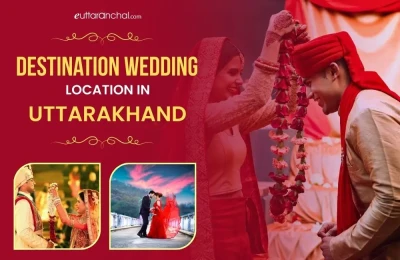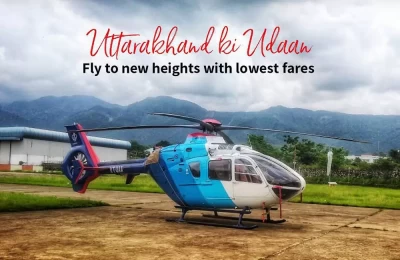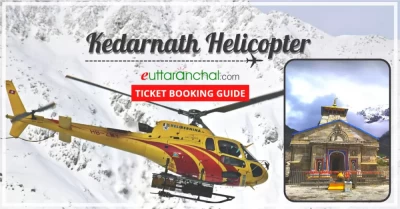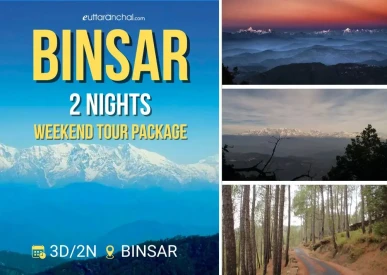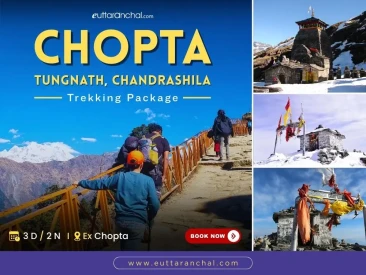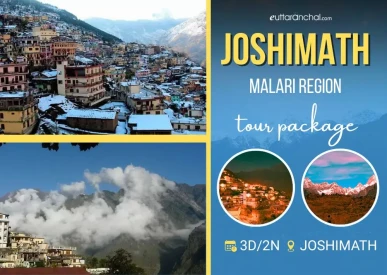How to Plan a Fairytale Winter Wedding in Uttarakhand

A winter wedding in Uttarakhand may seem like a fairytale. Snow-capped mountains, blue skies and hill towns with silence bring tranquillity and concentration, which fit intimate rituals and theatrical festivities. Organising a wedding in the mountains in winter is not like organising a wedding in a city: the weather, transportation, comfort of the guests, electricity and heating, and local licensing should be considered.
Why Uttarakhand Is Ideal for a Fairytale Winter Wedding
Uttarakhand is now a growing wedding destination due to its natural diversity and the fact that it is improving its infrastructure. It boasts diversified winter sceneries: snow-white Auli and Chopta, snow-white lake-side and hilltop Mussoorie and Nainital, accessible (and combinability) Rishikesh and Dehradun.
Certain hill stations have been marketed as destination wedding destinations due to the availability of better accessibility (airport and road) in such areas, which facilitates the movement of the guests during the winter seasons. The time between December and February is preferable foran actual snow experience in places such as Auli, where lower altitudes and foggy mornings are best in Mussoorie, Nainital, or Mukteshwar.
Choosing the Right Winter Month and Hill-Station Location
The month and venue are decided on, and they nearly dictate everything else. December through February are good months to visit when it's snowing and the weather is dramatic and cold; a month or two later in the year, towards the end of November or the beginning of March, is better when it is cold but clearer.
Auli is the best place to get snow and can offer snow or alpine views, depending on the year. Chopta is also a dependable place to get snow. Mussoorie and Nainital are suitable for couples who are not ready to travel much physically and endure extreme climatic conditions.
Remember to look at the weather trends in recent years on the dates you plan to be in the Himalayas, since the weather changes yearly. In the case of venues, seek out places that provide appealing outdoor spaces andlovely indoor or tented back-up space, as you will probably need to take some of your functions inside in case of bad weather. Uttarakhand has become popular with many resorts and hotels advertising winter wedding packages and heated indoors or tented options.
Advance Planning for Winter Travel and Guest Movement
Extra care is required in winter travel in the hills. Many venues in Uttarakhand are closest to the large airports like Jolly Grant Airport (Dehradun) and Pantnagar. Road transfers between airports must be scheduled to allow time for weather-relateddelays.
Improvements have been made to the infrastructure and new air services have been introduced recently, but mountain roads may close or become traffic-jammed during winter. Ifmany guests travel, post suggested arrival times and book several group transport services. Consider offering a travel warning containing information about winter tyres, emergency numbers and layering suggestions. The practical use of helicopter or small charter flights may be a viable option with VIPs travelling by air to remote locations, but this requires prior booking and safety inspections.
Pre-book for better convenience
Winter weddings need Caterers, florists, sound crews and lighting crews – vendorswith experience operating in cold conditions: battery performance is more quickly impacted in cold weather, drone regulation varies in mountain areas, and lighting and heating systems must be designed to operate safely in low-temperature conditions.
In the case of photography, the golden hour is earlier in the winter, and the daylight is shorter in time; thus, an effective shot list and schedule should be negotiated,emphasising the key frames. The vendors dealing with mountain weddings will also advise on permits and local regulations.
Book Early: Vendors, Photography, and Winter-Ready Services
Having guests warm and comfortable is one of the things that should be given priority: heated tenting and indoor spaces. Offer useful extras such as woollen blankets, hand warmers, hot beverage bars with options such as spiced tea, hot chocolate, warm soups, and coat checks.
Organise transport shuttles between accommodation and the venue, and have dry and heated waiting areas for older guests. A combination of shorter outdoor events (to take photos or have an entry) and longer indoor events to balance atmospheres and warmth is recommended by many planners.
Ensuring Guest Comfort with Warm Hospitality
The weather in the mountains during winter is unbearable. Make plans considering all outdoor events: tents that can instantly be covered and heated, a ballroom that can be used indoors to hold the ceremony in case of need, and covers over stages, lighting, and sound gear to protect against the rain and snow.
Power outages will not be an option; order a known generator and inquire about using cleaner fuels if you are concerned about sustainability. In the case of remote places, look at fuel delivery logistics and whether the place has sufficient capacity to be used long-term. It is prudent to conduct a brief test of any technical arrangements before the wedding day, so that the various teams can detect failures that may arise during cold conditions.
Establish a winter wardrobe/timeline
Winter weddings permit such luxurious materials as velvet, woollen blends and layered sarees. The wedding planners need to collaborate with stylists familiar with mountain weddings: dense fabrics are beautiful, but they can impede movement on frozen floors, and light-colored clothes require warm undergarments. Arrange the change of plans near the hot spots, not spending much time in cold between the looks.
To ensure the comfort of the guests and the photographer, outdoor photography and major ceremonies are held when the weather is warm, most often in late morning to early afternoon, and events in the evenings are held in well-covered areas.
Designing a Warm, Seasonal Food & Beverage Menu
Winter menus must be homely, seasonal and local. Hearty soups, hot starters, slow-cooked mains, and warm desserts make the visitors feel cared for. The inclusion of regional cuisines of Uttarakhand, which are simple, hearty meals made of regional products, gives it an authentic and home-cooked touch—hot drinks and after-dinner snacks maintain the momentum in evening events. In an outdoor cooking station or live counter, ensure food is safe at low temperatures, cover it, and insulate hot food.
Lights, Decor, and the Perfect Winter Wedding Colour Palette
Deep rich colours, burgundy, forest green, navy, white, and warm golds will suit a winter wedding palette. Bring warmth: warm LEDs, fairy lights, lanterns and fire where allowed. When outside, covered stages with transparent sides should be used to ensure that guests see the scenery, but are not exposed to cold air.
Look at weather-proof materials and do not use dainty flowers that are apt to turn brown in cold weather. Dried flowers and plants are frequently more successful with winter arrangements than summer flowers. Many planners incorporate green elements into their decor, such as reusable fabrics, potted plants, and aspects of local craft, which help minimise waste but not style.
Licenses, Local Regulations, and Respecting Mountain Culture
When temple ceremonies, forest places or locally owned heritage places form part of your celebration, confirm permissions. There are certain Himalayan and wildlife buffer zones in which the use of drones is limited or requires prior consent.
Other noise regulations, fire regulations and limits on temporary buildings also differ across local authorities. Enlist the services of a local planner or venue manager to know these rules and assist in filing permissions and communicating with panchayats or forest departments in case of necessity.
Budgeting for a Winter Wedding in Uttarakhand
Winter weddings have a few added expenses: heating and special tent insulations, power generators, snow removal or special vehicles, and, in some cases, indicating higher vendors' prices to cover winter allowances. Set aside some of your budget on those line items and contingencies.
If snowing is a key event, consider the money and effort required to reach snowy mountains without any problems. Increments of winter costs can be offset, on the other hand, by saving on decor through the use of a natural mountain background.
Sustainable and Locally Sourced Options for Winter Celebrations
Sustainability is even an issue during winter. Hire local florists that can find local greenery, hire caterers that use local produce, and do not use one-use plastics on location. Whenever you need something disposable, use biodegradable ones. Most mountain resorts encourage green policies and inquire about their disposal of waste, water conservation, and energy.
Acting in partnership with local producers - craftspeople, musicians, cooks - ensures that your event stays local and has a smaller environmental impact on transport emissions.
Winter Wedding Trends and Inspirations
Clear trends are being experienced in winter weddings. Couples opt to have micro-luxury weddings with a high-quality guest experience and lower guest count, making it easier to plan during winter logistically. Cosy decoration-- velvet, woollen accessories, hot drink bars and small-scale lighting- is trendy.
Photographers like early morning mist and late afternoon golden hour to take dramatic images, whereas videographers arrange fast staged outside shots to take a snow or mountain silhouette without exposure to the cold. Today, many establishments provide winter-specific packages, including heating, winter menu choices, and contingency plans. These innovations are simplifying winter weddings in the Himalayas and making them more certain than they used to be years ago.
Final Pre-Wedding Checklist for a Seamless Celebration
Make sure one has the date and a backup date that is weather conscious, make sure to have the venue and other necessary permits, find vendors who have experienced winter before, obtain dependable transport and power supply, make sure to have arrangements to comfort the guests (warmth, food, shuttles), and have backup plans on any one of the outdoor elements. Send a message on travel tips and packing lists to guests so everyone shows up prepared.
